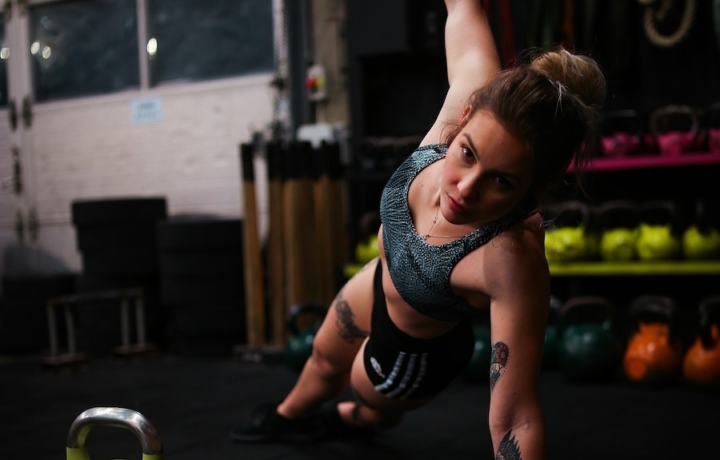Exercise
Flutter Kicks

Flutter Kicks
How to Perform
- Lie on your back with your legs extended and arms placed alongside your body, palms pressing into the floor for stability.
- Engage your core muscles by drawing your navel toward your spine and pressing your lower back firmly into the floor.
- Raise both legs about 6 inches off the ground while maintaining the posterior pelvic tilt position to protect your lower back.
- Lift your head and shoulder blades slightly off the floor, keeping your neck in a neutral position by gazing toward your knees.
- Begin the flutter motion by raising one leg higher while simultaneously lowering the other, keeping both feet off the ground at all times.
- Maintain a small range of motion (4-6 inches between legs) and focus on controlled movements rather than speed or height.
- Breathe normally throughout the exercise, avoiding the tendency to hold your breath as you stabilize your core.
- Continue alternating leg positions in a rhythmic, scissor-like motion while keeping your abdominals engaged and back pressed into the floor.
Important information
- Keep your lower back pressed firmly into the floor throughout the entire exercise to prevent arching and potential strain.
- If you feel any discomfort in your lower back, raise your legs higher off the ground or place your hands underneath your tailbone for additional support.
- Focus on the quality of movement rather than speed; slower, controlled flutter kicks engage the core more effectively.
- For beginners, start with 20-30 seconds and gradually increase duration as your core strength improves.

Flutter Kicks
Exercise Details
Primary Muscles
Muscle Groups
Mechanic
Built for progress
Take the guesswork out of training
Create personalized AI-powered workout plans that evolve with you. Train smarter, track every rep and keep moving forward, one workout at a time.






Flutter Kicks are a dynamic and effective intermediate-level exercise that primarily targets the abdominal muscles, making them an excellent addition to your core training routine. These deceptively simple movements engage multiple muscle groups simultaneously, with the primary focus on strengthening and toning the lower abs – an area many find challenging to develop.
This versatile exercise can serve multiple purposes in your fitness regimen. As part of a HIIT circuit, Flutter Kicks elevate your heart rate while building muscular endurance. During recovery phases, performing them at a controlled, slower pace helps maintain muscle engagement without excessive strain. They also function brilliantly as a warm-up component, activating the core before more demanding exercises.
Flutter Kicks excel at developing core stability and endurance, two crucial elements for both athletic performance and everyday movement. The continuous motion challenges your abdominals to maintain tension throughout the exercise duration, training them to support your spine during more complex movements. Regular practice improves your core's ability to stabilize your body during other exercises and daily activities.
What makes Flutter Kicks particularly valuable is their scalability. As your abdominal strength develops, you can increase the difficulty by extending the duration, adjusting your leg position, or incorporating them into more challenging combination movements. This progressive nature helps prevent plateaus in your core development.
Beyond the aesthetic benefits of a stronger, more defined midsection, Flutter Kicks contribute to functional fitness by enhancing the connection between your upper and lower body. This improved core strength translates to better posture, reduced risk of lower back pain, and enhanced performance in both athletic endeavors and everyday movements. The exercise exemplifies the principle that effective fitness training should combine intensity with precision for optimal results.
FAQ - Flutter Kicks
Flutter Kicks primarily target the lower abdominal muscles, while also engaging the hip flexors, quadriceps, and lower back stabilizers. The continuous motion creates sustained tension in the core, making it particularly effective for developing lower abdominal strength and endurance.
Beginners can perform Flutter Kicks with bent knees or for shorter durations (15-20 seconds). To increase difficulty, extend your legs fully, raise your shoulders off the ground, or add ankle weights for additional resistance.
The most common mistakes include rounding your lower back, rotating your hips instead of keeping them square, rushing through the movement, and not hinging properly at the hips. Focus on maintaining a neutral spine, moving with control, and keeping your standing knee slightly soft rather than locked.
Flutter Kicks can aggravate existing back problems if performed incorrectly. If you have back concerns, start with bent knees, place hands under your glutes for support, and stop if you feel any back pain. Consider consulting a physical therapist before incorporating this exercise.
Include Flutter Kicks 2-3 times weekly as part of your core training, performing 2-3 sets of 30-60 seconds each. Allow 24-48 hours between sessions for muscle recovery, especially if you're targeting the core intensely in your overall program.







